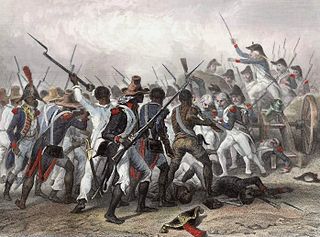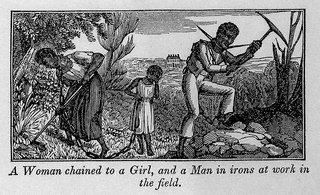Slavery in the Bahamas dates back several centuries.
| Part of a series on |
| Slavery |
|---|
 |
Slavery in the Bahamas dates back several centuries.
In December 1831, a slave riot occurred on the estate of Joseph Hunter, who had the largest slave holdings on Golden Grove. [1] Although the Consolidated Slave Act of 1797 stated that all slaves were entitled to rest on Christmas and the next two working days, Christmas in 1831 was on a Sunday which had already been an official rest day for slaves since 1830. Therefore, it was up to their owners to determine when their one outstanding rest day would be repaid. However, Hunter's slaves were displeased with his designation of the Saturday before Christmas week as their rest day; they continued to work on Saturday, collecting their Christmas allowances on Sunday instead, and demanded that Wednesday be their holiday. At the direction of senior slave "Black Dick" Deveaux, the slaves defied Hunter's orders to harvest corn on Wednesday and some were even accused by Hunter of stealing fruit. On 30 December, Black Dick, his sons, Wally and Richard, and the other slaves surrounded the Hunter estate; Black Dick and his sons were armed with muskets, although slaves were not permitted by law to bear firearms. A shootout ensued with no fatalities and the rebellion lasted for three days, while Hunter made preparations to leave for Nassau in early January 1832. [2] The perpetrators were subsequently arrested by the Second West India Regiment led and trialed on 25 January 1832; Black Dick and six other slaves were sentenced to death by hanging. [3]
Slavery was legally ended in all British colonies in 1833. The Creole case of 7 November 1841, which has been described as "the most successful revolt of enslaved people in U.S. history", a mutiny occurred on the New Orleans-bound Creole, which was transporting some 135 slaves from Richmond, Virginia. After wounding the captain and killing one of the slave traders, the mutineers navigated the ship to the Bahamas, where all the slaves onboard ultimately found their freedom. [4]
In 1992, the Pompey Museum of Slavery and Emancipation, named after "a courageous slave, Pompey, who lived on the Rolle Plantation on Steventon, Exuma", was established at the former Vendue House marketplace at Bay Street, Nassau. [5] In October 2013, following a Caribbean Community (CARICOM) meeting on reparations in Saint Vincent and the Grenadines, the Bahamas joined 13 other CARICOM states in formally demanding slavery compensation from Britain, Holland, and France. [6]

The Bahamas, officially the Commonwealth of The Bahamas, is an island country within the Lucayan Archipelago of the West Indies in the North Atlantic. It takes up 97% of the Lucayan Archipelago's land area and is home to 88% of the archipelago's population. The archipelagic state consists of more than 3,000 islands, cays, and islets in the Atlantic Ocean, and is located north of Cuba and northwest of the island of Hispaniola and the Turks and Caicos Islands, southeast of the U.S. state of Florida, and east of the Florida Keys. The capital is Nassau on the island of New Providence. The Royal Bahamas Defence Force describes The Bahamas' territory as encompassing 470,000 km2 (180,000 sq mi) of ocean space.

The legal institution of human chattel slavery, comprising the enslavement primarily of Africans and African Americans, was prevalent in the United States of America from its founding in 1776 until 1865, predominantly in the South. Slavery was established throughout European colonization in the Americas. From 1526, during early colonial days, it was practiced in what became Britain's colonies, including the Thirteen Colonies that formed the United States. Under the law, an enslaved person was treated as property that could be bought, sold, or given away. Slavery lasted in about half of U.S. states until abolition. In the decades after the end of Reconstruction, many of slavery's economic and social functions were continued through segregation, sharecropping, and convict leasing.

The Baptist War, also known as the Sam Sharp Rebellion, the Christmas Rebellion, the Christmas Uprising and the Great Jamaican Slave Revolt of 1831–32, was an eleven-day rebellion that started on 25 December 1831 and involved up to 60,000 of the 300,000 slaves in the Colony of Jamaica. The uprising was led by a black Baptist deacon, Samuel Sharpe, and waged largely by his followers. The revolt, though militarily unsuccessful, played a major part in the abolition of slavery throughout the British Empire.

Samuel Sharpe, or Sharp, also known as Sam Sharpe, was an enslaved Jamaican who was the leader of the widespread 1831–32 Baptist War slave rebellion in Jamaica.

Emancipation Day is observed in many former European colonies in the Caribbean and areas of the United States on various dates to commemorate the emancipation of slaves of African descent.

The coastwise slave trade existed along the eastern coastal areas of the United States in the antebellum years prior to 1861. Shiploads and boatloads of slaves in the domestic trade were transported from place to place on the waterways. Hundreds of vessels of various sizes and capacities were used to transport the slaves, generally from markets of the Upper South, where there was a surplus of slaves, to the Deep South, where the development of new cotton plantations created high demand for labor.
The Creole case was a slave revolt aboard the American slave ship Creole in November 1841, when the brig was seized by the 128 slaves who were aboard the ship when it reached Nassau in the British colony of the Bahamas where slavery was abolished. The brig was transporting enslaved people as part of the coastwise slave trade in the American South. It has been described as the "most successful slave revolt in US history". Two died in the revolt, an enslaved person and a member of the crew.

Bussa's rebellion was the largest slave revolt in Barbadian history. The rebellion takes its name from the African-born slave, Bussa, who led the rebellion. The rebellion, which was eventually defeated by the colonial militia, was the first of three mass slave rebellions in the British West Indies that shook public faith in slavery in the years leading up to the abolition of slavery in the British Empire and emancipation of former slaves. It was followed by the Demerara rebellion of 1823 and by the Baptist War in Jamaica in 1831–1832; these are often referred to as the "late slave rebellions".

The Black Seminoles, or Afro-Seminoles, are Native American-Africans associated with the Seminole people in Florida and Oklahoma. They are mostly blood descendants of the Seminole people, free Africans, and escaped former slaves, who allied with Seminole groups in Spanish Florida. Many have Seminole lineage, but due to the stigma of having very dark or brown skin and kinky hair, they all have been categorized as slaves or freedmen.

The Slave Compensation Act 1837 was an Act of Parliament in the United Kingdom, signed into law on 23 December 1837. With the Slavery Abolition Act 1833, it authorized the Commissioners for the Reduction of the National Debt to compensate slave owners in the British colonies in the amount of approximately £20 million for the freeing of slaves. Based on a government census of 1 August 1834, more than 40,000 awards to slave owners were issued. Since some of the payments were converted into 3.5% government annuities, they lasted until 2015. Most were sold and the money sent abroad for investment.

The institution of slavery in North America existed from the earliest years of the colonial history of the United States until 1865 when the Thirteenth Amendment abolished slavery throughout the United States except as punishment for a crime. It was also abolished among the sovereign Indian tribes in Indian Territory by new peace treaties which the US required after the Civil War.
Afro-Bahamians are an ethnicity originating in The Bahamas of predominantly or partial African descent. They are descendants of various African ethnic groups, many associated with the Bight of Biafra, Ghana, Songhai and Mali, the various Fula kingdoms, the Oyo Empire, and the Kingdom of Kongo. According to the 2010 Census, 92.7% of The Bahamas' population identifies as Black African descent.

Slavery in Virginia began with the capture and enslavement of Native Americans during the early days of the English Colony of Virginia and through the late eighteenth century. They primarily worked in tobacco fields. Africans were first brought to colonial Virginia in 1619, when 20 Africans from present-day Angola arrived in Virginia aboard the ship The White Lion.

Slavery played the central role during the American Civil War. The primary catalyst for secession was slavery, especially Southern political leaders' resistance to attempts by Northern antislavery political forces to block the expansion of slavery into the western territories. Slave life went through great changes, as the South saw Union Armies take control of broad areas of land. During and before the war, enslaved people played an active role in their own emancipation, and thousands of enslaved people escaped from bondage during the war.
Buckra or Backra is a term of West African origin. It is mainly used in the Caribbean and in the Southeast United States. Originally, it was used by slaves to address their white slave master. Later the meaning was broadened to describe white people in general.

Reparations for slavery is the application of the concept of reparations to victims of slavery and/or their descendants. There are concepts for reparations in legal philosophy and reparations in transitional justice. Reparations can take many forms, including practical assistance to the descendants of enslaved people, acknowledgements or apologies to peoples or nations negatively affected by slavery, or honouring the memories of people who were enslaved by naming things after them.
The Enterprise was a United States merchant vessel active in the coastwise slave trade in the early 19th century along the Atlantic Coast. Bad weather forced it into Hamilton, Bermuda waters on February 11, 1835 while it carried 78 slaves in addition to other cargo. It became the centre of a minor international incident when the British authorities freed nearly all the slaves. Britain had abolished slavery in its Caribbean colonies effective 1834. At that time it advised "foreign nations that any slavers found in Bermuda [and the Bahamas] waters would be subject to arrest and seizure. Their cargoes were liable to forfeiture" without compensation.

Slavery in Florida is more central to Florida's history than it is to almost any other state. Florida's purchase by the United States from Spain in 1819 was primarily a measure to strengthen the system of slavery on Southern plantations, by denying potential runaways the formerly safe haven of Florida.

Marriage of enslaved people in the United States was generally not legal before the American Civil War (1861–1865). Enslaved African Americans were considered chattel legally, and they were denied human or civil rights until the United States abolished slavery with the passage of the Thirteenth Amendment to the United States Constitution. Both state and federal laws denied, or rarely defined, rights for enslaved people.